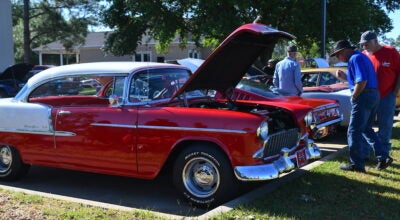Munnerlyn Steamboat named for family
Published 4:40 pm Monday, January 12, 2009
Long ago, the name Munnerlyn was very popular up and down the Chattahoochee and Flint rivers.
The Munnerlyns were well known for their hospitality and devotion to the welfare of our area—before and after the Civil War. They were considered leaders in their day and left behind a rich legacy.
Our area was also famous for the steamboats that plied the rivers daily. Some boats were known for their bravery during the times when Indians hid on the rivers’ edges and attacked them as the boats steamed by. Other boats were known for their courage as blockade runners during the Civil War.
Still other steamboats had reputations as being steadfast, dependable working boats. They hauled cotton, peanuts and other important crops as well as supplies to and from ports, keeping a shipping lifeline open all along the rivers.
With the reputation that the Munnerlyn family had, it just seemed that the naming of a steamboat after them was the thing to do.
The steamboat Munnerlyn was known as a steady worker. One that finished the voyage even in adverse conditions.
A 106-ton sternwheeler, it was built at a ship yard in Monongahela, Pa., in 1859. She needed only 2 feet and 2 inches of water to float. This was very important back when the rivers ran wild and free, when their water depths were not dictated by man. Also, its hull was expressly designed with the twists and turns and shallows on the Flint River in mind.
The Munnerlyn started hauling cotton from Georgia fields down the Flint River to the Apalachicola River, then on down to the Gulf of Mexico. On its return trip up north, it would carry salt, oysters and other sea foods.
With tension growing between the North and South, the cargo that the Munnerlyn carried became more varied. The loads grew in size too. Because of its hull construction, the boat was capable of carrying up to 350 tons of freight all year round. The Munnerlyn worked hard to keep its important cargo going to the ports that were in need.
Even though the Munnerlyn was built with the shallowness of the rivers in mind, it was still at the mercy of the falling waters. As an example, in 1860, it found itself aground in the undignified position of having its bow rising up to face the sky and its stern digging deep down into the muddy bottom of the Flint.
This situation was not uncommon because the weight of the cargo and the engines was all placed in the stern of a steamboat. Unfortunately for the Munnerlyn, when it went aground in 1860 it sustained structural damage. Its timbers had bent and separated. Eight days of repair work to its hull was required to make it seaworthy once again.
When finally afloat, the Munnerlyn once again sat trim and even in the water. It made its way on down the Flint River as if nothing had happened. On its return trip, its cargo reflected the growing urgency before the war. It carried a full load of cotton and corn up the Flint River and on its way back, it carried a full load of hay and plows.
The Civil War’s effect
When the Civil War did come, the Union blockade had an effect on steamboat shipping on the rivers. The steamboats that were working on the rivers at this time remained on duty for as long as there was cargo to run.
The Confederacy controlled all the river traffic that took place in this area. The men who worked on these steamboats were not drafted into the service. It was felt that they already were performing a necessary function.
For the most part, the Munnerlyn kept its schedule. Only at times, when the rivers grew temperamental, were there delays. However, with the blockade in the Gulf and the Union Army pressing ever closer, the ports that the Munnerlyn served became fewer and fewer.
The Union had set up a blockade in the Gulf right near the mouth of the Apalachicola River. In answer to this, the South had its blockade runners. Even though the gunboats made valiant efforts to break the blockade, the number of ports still shrunk. Ultimately, the Chattahoochee River became the only river to remain fully open.
On the Chattahoochee, the war effort was a top priority. Industries at Columbus, Ga., had increased their production of goods to help the Confederacy in the war effort. At the time, there were three river steamboats running regularly ion the Chattahoochee River. The Munnerlyn was one of these.
After six years of faithful service supplying residents and troops along the Chattahoochee, the Munnerlyn was refitted with a new hull. However, its original engines—the heart of the boat—were not overhauled. Still, they kept running.
After being refitted, the Munnerlyn acquired a new owner. He was especially proud of the fact that it only needed 23 inches of water to float. However, he wanted it to float in even more shallow waters, so once again she received a new hull. This time the Munnerlyn could float in only 16 inches of water. To show off this new hull, its owner hosted a champagne party on board.
After the party, the Munnerlyn made her way down the Chattahoochee River to Chimney Bluff where it was pressed into service to help salvage metal from a gunboat, which the Union Navy had blown up. The Munnerlyn carried tons of iron, making two trips. This excessive weight cause a lot of stress on her new, untested shallow-draft hull.
While tied at its dock, the Munnerlyn, sadly and quietly sank in a area known as the Narrows on the Chattahoochee River in March of 1867. Her owner tried to raise it but decided it was futile and abandoned it at the beginning of April.
One feels that he should have tried harder to bring it up. The Munnerlyn deserved more of a chance to continue on. Perhaps it was the owner’s fault because in creating a very shallow hull, he may have weakened its structure. In any event, the river lost a valuable asset.





